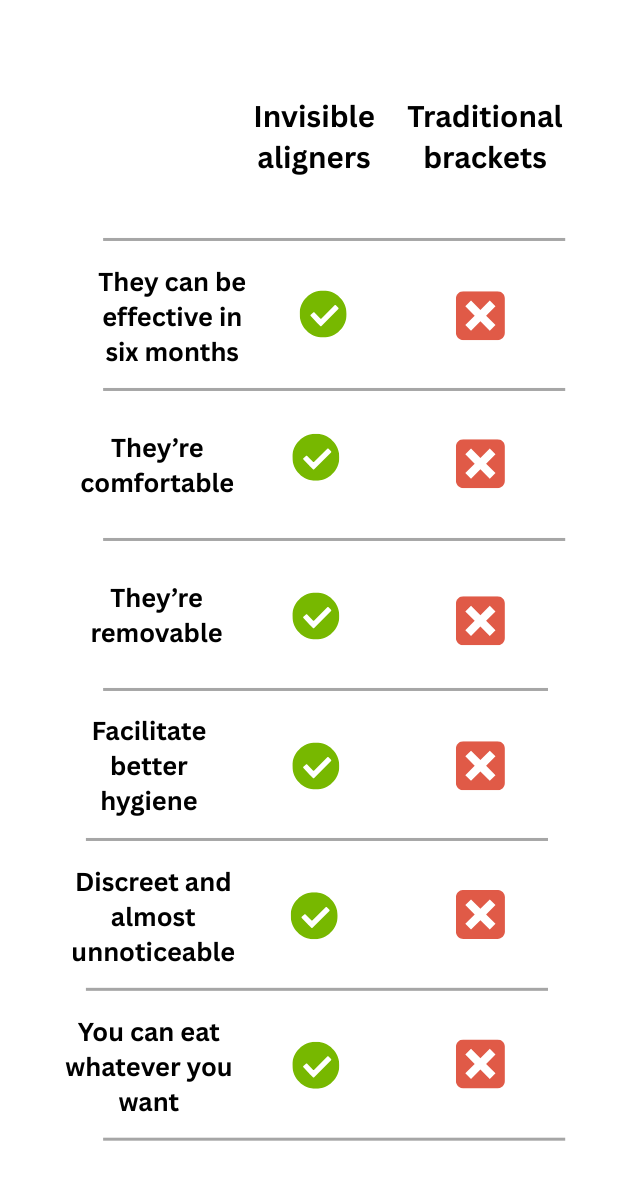Clear aligners vs braces: the differences between them and aligners
People of varying ages are investing in teeth straightening at an exceptional rate. Due to more accessible disposable income, and treatment options, people can finally take ownership of their health. Patients want to tackle a range of malocclusion complaints:
- dental crowding
- bite problems
- gaps or diastema
Aligners or braces
There are a lot of options on the market, from hybrid providers to traditional metal braces, or "train-track" braces.
The braces vs aligners debate has dental professionals and possible patients in both camps. For many people, the decision is based depending on: the type of treatment, their budget and the timeframe they have to drive results.
Sometimes it can be difficult to understand the differences between ceramic braces, conventional braces and sets of aligners. Let's look at the main differences between braces and aligners, which, though equally effective, have different characteristics.
What are braces?
- Braces are small metal pieces that are attached to the surface of your teeth with metal wire.
- The wire creates a connective arch.
- The arch works by connecting and applying continuous pressure on the dental pieces.
- Progressive tooth movements occur until the teeth move into the correct position.
What types of braces are there?
There are several types of braces: metal, clear, lingual and self-ligating. Benefits and disadvantages exist, which may mean you like the idea of one more than the other.
Cons of braces
- Appearance and cost vary for clear braces, or sapphire, lingual and self-ligating braces.
- They share the common feature - they’re fixed and not removable until the end of treatment.
- Risk of sores or accidents, as they can't be removed to practice sports.
- Nor can they be removed for dental hygiene or the consumption of certain foods, all of which we’ll address later.
Clear or invisible aligners in contrast, are removable splints that are placed on top of the teeth and perform the same function as braces: correct dental malpositions by applying pressure. They offer:
- A shorter treatment time on average
- They're comfortable to wear
- As the name suggests, they're virtually invisible
- Remove them for brushing and flossing
Which is more effective: braces or aligners?
When it comes to dental aligners vs braces effectiveness, aligners are just as effective as braces.
In other words, rather than discussing the distinction between the capabilities of clear aligners vs metal braces. It’s more relevant to consider the methods used to achieve the goal and the characteristics of each product.

Are aligners or braces more discreet?
Braces
Metal bracket and wire braces are not discreet and are usually visible when a person smiles, or opens their mouth.
That’s because they are placed on the vestibular side (visible part of the tooth). Whether they are metal (traditional or self-ligating), or clear (ceramic or sapphire brackets), they can be seen to some degree.
Lingual braces, on the other hand, are the single exception to visible braces. They are placed on the lingual side (part of the tooth facing inside the mouth), so they are not as visible from the outside.
You pay a premium for this additional technicality! Prices go up to £7,000 to have them fitted on the inside of your teeth. Some people experience bite issues and sores with lingual braces, as they're hard to clean and adjust your mouth and tongue placement.
Aligners
Straightening your teeth with aligners is a great choice for lots of dental correction needs. They achieve your desired position pretty quickly, and keep your teeth cleaning simple - as they're removable too.
Their transparent appearance makes them attractive for people concerned with the look and feel of braces. The benefit of that is that they're made to adapt completely to the anatomy of your mouth. This makes correcting crooked teeth and other misalignments almost imperceptible.

Benefits of Aligners
On the other hand, we have completely removable aligners. This makes things much easier, since you can take them off whenever you want, such as to eat or brush your teeth, or play sports.
However, it should be noted that dentists and orthodontists recommend wearing aligners for a minimum of 22 hours a day. This is in order to successfully carry out all the necessary movements.
Are braces comfortable?
When comparing clear aligners vs metal braces, comfort is another important point to consider.
- Braces can cause discomfort since there can be chafing in the soft tissues on the inside of the cheek. They can end up forming canker sores or, on some occasions, even deeper wounds.
- A protruding wire can cause problems eating, as digs into the cheek.
- You typically need to schedule an appointment to fix it.
- Patients also tend to notice some pressure on the teeth after each adjustment.
Luckily, some of these discomforts are avoidable thanks to special wax that can block pokes and scratches.
Are aligners comfortable?
Impress aligners are made of a rigid and robust medical quality plastic, and their surface is smooth and delicate with the mouth’s soft tissue. Chafing and sores to form with invisible aligners vs braces is less likely.
As for the pressure, it’s possible to notice some when changing from one aligner to another. However, since the changes are very frequent, this sensation is hardly noticeable and is very light.

Orthodontic Hygiene
Cleaning Braces
With braces, daily oral hygiene is a bit more difficult as the dental surface is no longer normal, requiring more attention to detail when cleaning.
In addition, another dental hygiene essential is floss. Flossing becomes much more difficult with a metal arch blocking the spaces between the teeth.
Cleaning your aligners
If you’re still asking if clear aligners are easier to keep clean than braces, this section might answer your questions. The complications of good oral hygiene don’t exist with aligners.
When you brush your teeth and floss, it's as simple as removing the aligners, allowing you to brush just as before.
What you can't eat with braces
With braces, you have to be careful with certain hard foods such as hard sweets and other food that you use incisors and canines to breakdown, such as apples.
This is because braces are glued to the dental surface with a special glue, so if you apply too much force, they can come off. If this happens, you’ll have to go to the clinic to glue them again and, therefore, lengthen the duration of orthodontic treatment.
In addition, the consumption of sticky foods can also be an issue since they’re difficult to clean and should be avoided when wearing clear, ceramic or sapphire braces.
Orthodontics with coloured braces that mimic the natural shade of tooth enamel can easily be stained by the consumption of tea, coffee or certain spices.
This restricted diet is another reason more people are choosing invisible orthodontics when contemplating teeth aligners vs braces.
Eating with aligners
You can enjoy any type of food without much of a problem when wearing aligners. Simply take out the aligners and store them in their box until it’s time to put them back in after brushing your teeth.
The only time we recommend being extra cautious is when the treatment involves the use of attachments, since these can also come off when chewing very hard food.
However, treatment can continue without problem for a few days even if an attachment has become dislodged with teeth aligners vs with braces, which need to be fixed immediately.
Regardless, it’s important to notify your orthodontist and fix any broken pieces as soon as possible.
Clear aligners vs metal braces: what type of orthodontic treatment is best for me?

Impress: specialists in invisible orthodontics
If you plan to start an invisible orthodontic treatment, you’ll be in good hands at Impress. In addition to all the advantages mentioned above, with Impress you can enjoy other benefits.
We offer different types of treatments, depending on your needs and the complexity of your case. You'll benefit from knowing fixed prices - no nasty surprises. Additionally, we offer financing options to pay for your orthodontic treatment in instalments.
Get in contact with us by phone or WhatsApp at +44 20 3808 1072 or, book an appointment online through our website.
Visit us at your nearest Impress clinic for your free orthodontic check, and discover the treatment that’s best for you. We can’t wait to meet you!
Updated: October 2025




